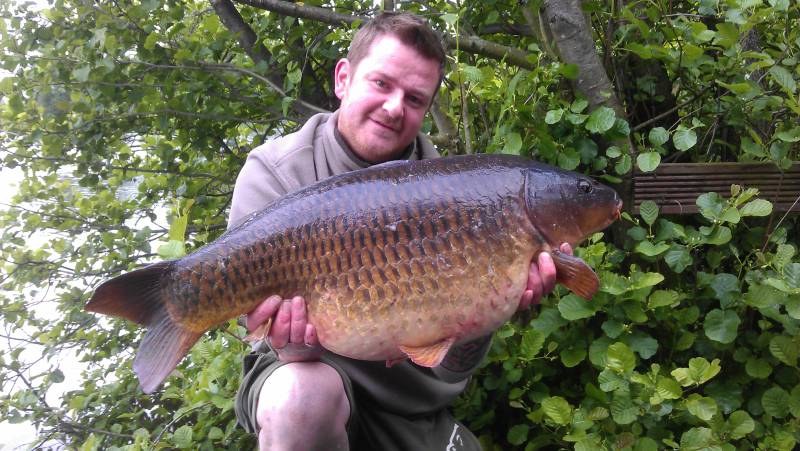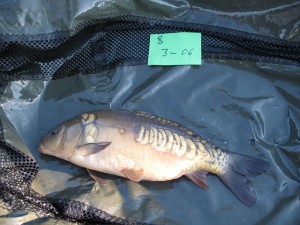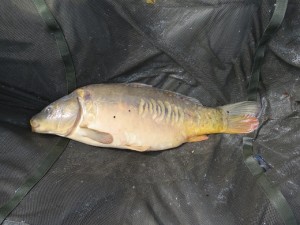In the February of 2010, I was thrown into the deep end by taking on a local estate lake and running a carp syndicate on the lake. I had been a member of the syndicate for a number of years and had fished there since 1985. When I first fished the lake there were 12 carp in the near 5 acre lake, ranging from 18lb to 29lb. Big fish for the time and massive for our area.
Most of the carp were over 24lb so you can see the attraction. The carp were old, and one by one they slowly died until we were fishing for around 5 fish.
A local club took over the fishing rights, then followed by a couple of different syndicates which resulted in some much needed extra stock being introduced. The lake grew on a few low 30lb common carp over the years but in 2010 there was only 1 known thirty left alive, with around 25 other mirrors and common carp ranging from 14lb to 28lb. In the stock pond were 10 carp as back ups to replace any lost fish in the main lake.
By the time I took over the lakes were in need of some much needed TLC and I needed a good syndicate to help me develop my vision. The old syndicate remained with a couple of additional members so as to collect in the required fees to pay for the lease and work to be carried out.
My Project
The lake at around 5 acres was shallow with deep silt all over the lake bed, some stagnant old smelly stuff. The water needed to be deepened by controlling the sluices correctly and somehow removing or reducing the depth of the silt as well as rejuvenating the silt to create a perfect environment for natural water life. I pulled all my fishing knowledge and experience together to create a list of things that I would want to do to progress the lake into a better fishery;
- A total replacement of 3 old fishing stages to make them suitable to comfortably house both bivvy and angler. My previous experience from work parties on the famous Mangrove would put me in good standing to direct a project to get this work completed.
- Liming the lake to breakdown the lake bed to naturally increase water depths and to improve the water and silt condition.
- Repair work on the dam.
- Improve control on two sluices in order to increase the over all depth of the lake.
- To register the lakes with Cefas so that I can make purchases of new carp and to legally transfer carp from my stock lake to the main lake or visa versa.
The Stage Work
The stages needed a total revamp so it was a joint effort by all the members and the lake owner to provide materials to build the stages from scratch. All 3 stages are set over boggy silted areas with 2 of them requiring walkways.
Sleepers, scaffolding poles and clips, planks and marine ply boards would be needed. Everybody contributed something and the materials kept piling up on our car park. Within 3 weeks we were in a position to start work on all of the stages. We stripped every stage down totally. Iron workings were set for the foundation with all the woodwork structure being above the water line, creating 3 stages with an average area of 4 by 5 meters, big enough to accommodate most bivvies and to give the angler sufficient room to fish in comfortably.
The Dam
The dam was in a poor state of repair with water breaching it in a number of places. The work would have to be done in sections due to cost. This took place over a 2 year period which comprised of strengthening and thickening the wall holding back millions of gallons of water. Over 4 tons of concrete was used for this project with quite a few work parties. Fortunately I have all walks of life in the syndicate which includes bricklayers and ground workers and the work is now successfully completed with no leaks or breaches. Improvements were made to the sluices so that I had some control on the water levels.
Liming The Lake
The use of Hydrated lime or Siltex is commonly used on silty lakes to breakdown and improve the quality of the lake bed. With siltex, it is expensive and the whole of the lake has to be done in one treatment. With hydrated lime it is much cheaper and only a section of the lake has to be treated each year.
On my low budget, I selected the cheaper option with the hydrated lime. As I took on the lake I limed a quarter of the lake immediately and a second quarter of the lake 6 weeks later. The following winter I limed the other half of the lake in two sections, so by the spring of 2011, the whole lake had been treated.
The 2011-2012 winter I treated a third of the lake with 15 bags of hydrated lime, with the following 2 winters the other 2 thirds. I like to get the lime into the lake before there is any chance of a freeze so I aim for mid December to start the treatment, and the carp still feed in the untreated areas. Within 2 weeks the whole lake is back to normal.
The benefits to liming are better water quality, reducing fish lice and leeches, increasing all invertebrate and insect life, consequently increasing the health of the fish and increasing weights, and ofcourse the breakdown of silt which deepens the lake naturally.
Fish stocks
Whilst all this was going on it was my intention to increase fish stocks in both my main lake and also the 1.7 acre stock pool. Again we were working on a tight budget so the fish that I would be purchasing would be from a local fish farmer and they would be small and at the lowest price possible.
I had to go through the procedure of registering both my lakes with Cefas so that I could legally purchase the new stock. Registering with Cefas does not cost a penny, it is just a matter of filling out a few forms and waiting a couple of weeks for the paperwork.
Since taking on the lakes I have carefully increased the stocking level with a total of around 45 carp, most being stocked into my stock lake. The biggest purchases of carp were fish 18 months old and weighing around 2lb, this ensuring that the stockies were young fast growing carp.
My lakes are now stuffed with natural food from the liming and the growth rates are phenomenal. At 30 months old they are averaging between 5 and 6lb. I estimate that in 2 years they will be close to the 20lb mark. I have a few three and a half year old fish that are now in the mid teens already.
Feeding programme
Believe it or not I do not feed the lakes. What the Members and myself do is throw any unused bait into the stock pond. I’ll also feed the odd kilo of carp pellet and particle. We depend on the fish feasting on the large natural larder to gain their weight and it is working. This winter I fed the fish with maize and a few boilies just to keep them active for as long as possible before the real cold winter set in.
It is 4 years since I took on the project, the lake produced it’s first 40lb carp 2 years ago and we have a few of the older fish over 29lb with a few un-caught 30lb commons. The future of the lake will be my new stocked fish, which I envisage will over take the weights of the older fish in a couple of years. They have had a great start in life and are used to feeding hard, competing with the other carp in the lake. I will keep you posted.
Paul Cooper
Read more of Paul’s articles here






Hello Paul
We were interested to read your article and what you have achieved with this project. We are in a similar situation here in Devon and wondered if we might be able to make a contact with you – not sure where you are in the UK though!
We look forward to hearing from you
Hazel Rimmer